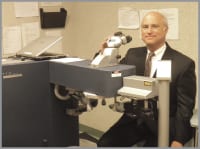Seeing The Light Image-guided Technology Is Changing The Course Of Spinal Surgery
Although the most significant contributions to spinal reconstruction, deformity correction, and stabilization have been made during the last 30 years, surgical pre-planning remains an important preparatory step in any spinal procedure.
Reviewing the patient’s X-rays, CT scans, or MRI studies helps the surgeon to visualize the surgical process in his or her mind’s eye. Today, through image-guided surgery (IGS), the spine surgeon is able to see the procedure as it is performed in real time.
IGS illustrates how advancements in instrumentation, computer technology, and imaging have been developed to help surgeons perform complex spinal reconstructions more safely and quickly than ever before.
Recent Developments
The concepts behind IGS are similar to those in a Global Positioning System (GPS). Although GPS was developed for military use to guide missiles, it has become a mainstream tool utilized by professionals ranging from archaeologists to search and rescue teams, and it is even an option available on some new cars today.
Image-guided surgery is actually part of a technology known as computer-assisted surgery (CAS). IGS provides the surgeon with image visualization and analysis capabilities during live, or ‘real-time,’ surgery. This impressive technology was first used several years ago by neurosurgeons to navigate the complexities of the brain during difficult operations. Today, spinal surgeons are adapting image-guided surgical techniques to many laparoscopic and endoscopic procedures to surgically reconstruct and stabilize the spine.
The first step is pre-operative planning. Prior to the patient’s surgery, CT or MRI scans are taken. These images are transferred to tape or optical disc to be read by the system’s computer during surgery. Pre-operative imaging decreases or eliminates the need for intraoperative X-rays, thereby sparing the patient and surgeon radiation exposure.
An optical camera is stationed in the operating room to receive signals from special digitized instruments equipped with light-emitting diodes (LEDs). During surgery, the camera receives and sends the signals to a high-speed computer. The signals are received from both the instrument and the patient.
The optical camera uses triangulation, a form of geometry, to establish the distance between two points (instrument position and patient anatomy). The computer integrates the ‘triangulated signals’ onto the patient’s CT or MRI scan images. An image is then generated, projecting the instrument’s exact location in relation to the patient’s anatomy. The surgeon views the image on a nearby screen, typically a computer monitor, to see the exact location of the instrument.
Using sub-millimetric accuracy, these image-guidance systems can pinpoint exactly where the tip of a surgeon’s instrument is in relation to a patient’s anatomy. Although not generally necessary for routine spine procedures such as microdiscectomies, this technology can provide invaluable information to a surgeon who encounters distorted or unusual anatomy during a complex spinal-stabilization procedure.
The images generated through use of IGS are not just one-dimensional. The computer is capable of preparing three-dimensional models that accurately reflect the position of the instrument superimposed on the image. Three-dimensional views can assist the surgeon in the precise placement of bone screws. Further, IGS assists the surgeon by providing the means to reorient an abnormal anatomy that can be misleading.
To take this technology a step further, helmets have been designed that incorporate an internal screen onto which real-time images are projected. These images guide the surgeon throughout the complex spine procedure.
Not Quite Perfect
During some surgical procedures, the patient is repositioned on the operating table. In patients whose spinal anatomy is unstable (as in the case of severe scoliosis), even minor movement can alter physical spinal anatomy. This presents a problem because the CT and/or MRI scans obtained pre-operatively may no longer be reliable following patient movement. However, all is not lost.
Virtual fluoroscopy (VF) is another type of image-guided companion for the spine surgeon. Using VF, the surgeon obtains a fluoroscopic X-ray during surgery. Using the same LED technology as in IGS, the computer re-triangulates the coordinates again and again providing updated images for the surgeon’s use in multiple planes (such as 3D). Virtual fluoroscopy enables the surgeon to navigate his instruments in ‘real time.’
In conclusion, image-guided surgery and virtual fluoroscopy offer many benefits, which include the enhancement of the surgeon’s ability to navigate complex spinal anatomy in real time, the ability to place bone screws more precisely, a reduction in operating time, and the minimizing or complete elimination of radiation exposure.
However, neither technique replaces or is a substitute for surgical pre-planning. Most surgeons agree that pre-planning is an important preparatory step for integrating the procedural steps in their mind’s eye. After all, even in the rapidly advancing world of surgery, some things never change.
Dr. McLaughlin is a former instructor of Neurological Surgery at Tufts University School of Medicine who practiced at the Neurosurgical and Neurological Group in Springfield. He is a fellowship-trained spine surgeon and is on the topic editorial board of spineuniverse.com


